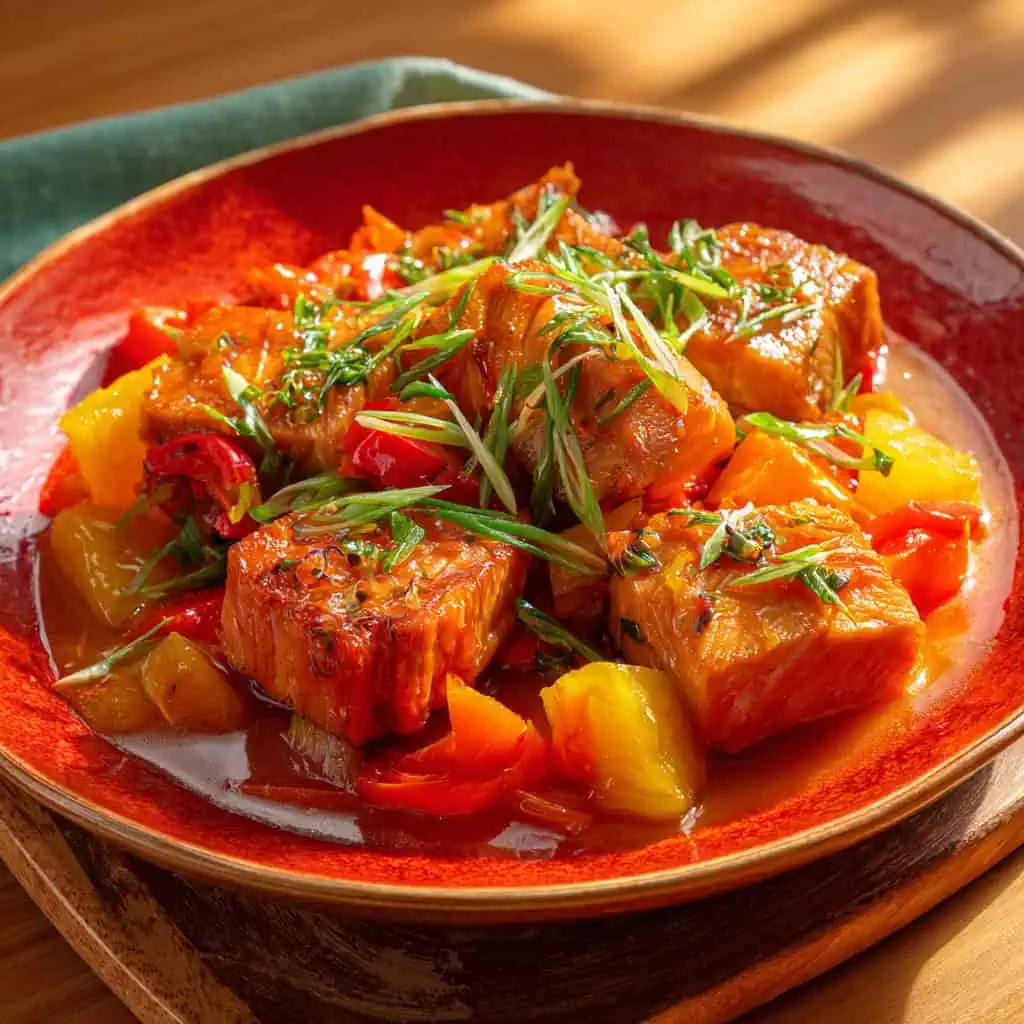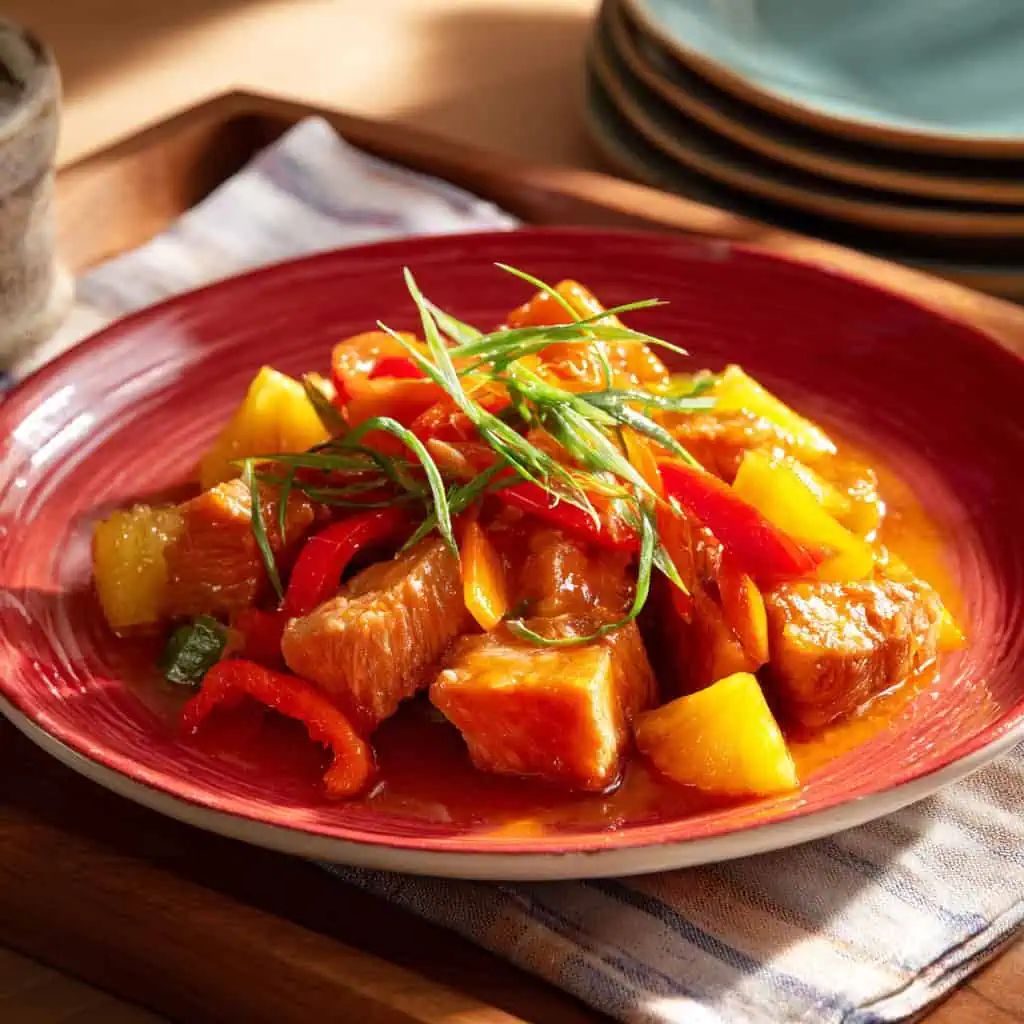Some of the best recipes come from the most unexpected places. My ex actually introduced me to this amazing sweet and sour tuna dish during one of our weekend cooking sessions. It became one of my absolute favorites.
We're still friends, and I'm grateful he shared this gem with me. This Filipino-style escabeche is nothing like the typical Chinese sweet and sour you might know. It's got this incredible depth from fresh ginger and pineapple that just makes your taste buds dance. The fish gets perfectly crispy on the outside while staying tender inside, then gets smothered in this glossy, tangy sauce.
Once you try this 30-minute wonder, it'll become your go-to when you want something that looks fancy but is surprisingly easy to make.
Jump to:

Why You'll Love This Recipe
This Filipino-style sweet and sour tuna brings together the perfect balance of crispy fish and a vibrant, tangy sauce that's completely different from Chinese versions. The secret lies in the fresh ginger that makes the sauce absolutely sing, while the pineapple adds natural sweetness and the vinegar brings that signature Filipino tang.
It's a one-pan wonder that transforms simple tuna into a restaurant-quality dish that's both comforting and exciting. Plus, it's ready in just 30 minutes, making it perfect for busy weeknights when you want something special without the fuss.
Ingredients
- 1-2 pounds tuna, deboned and cut into large chunks
- 4 garlic cloves, peeled and minced
- 1 cup mixed bell peppers (red and green), sliced
- 1 medium onion, chopped
- 1 small carrot, cut into strips
- 1 scallion, cut into strips
- 1 thumb-sized piece fresh ginger, peeled and cut into thin strips
- 20 oz can pineapple chunks (reserve the juice)
- 4 tablespoons tomato paste
- ½ cup brown sugar
- 2 tablespoons soy sauce
- ½ cup white vinegar
- 1 ½ cups water
- 1 tablespoon cornstarch
- 1 cup cooking oil

Each ingredient plays a crucial role in building the complex flavors of this dish. The tuna provides a meaty base that holds up beautifully to frying, while the ginger and vinegar create that signature Filipino tang.
The pineapple juice adds natural enzymes that tenderize the fish and contribute sweetness, balanced by the brown sugar for depth. The vegetables add color, crunch, and nutrition, while the cornstarch creates that glossy, restaurant-style sauce that coats everything perfectly.
Equipment
- Large pan or wok - for frying the tuna at high heat and achieving that perfect crispy exterior
- Medium saucepan - for making the sweet and sour sauce without overcrowding
- Paper towels - essential for draining excess oil from the fried fish
- Small mixing bowl - for creating the cornstarch slurry that thickens the sauce
- Sharp knife and cutting board - for prepping all the vegetables uniformly
- Wooden spoon or spatula - for stirring the sauce without scratching your pans

How To Make
- Heat the cooking oil in a large pan or wok over medium-high heat until it shimmers and is hot enough for frying. This usually takes about 2-3 minutes.
- Carefully add the tuna chunks to the hot oil and give them a gentle stir to prevent sticking. Let one side cook undisturbed for about a minute until it develops a beautiful golden-brown crust.
- Flip the tuna pieces over using a spatula and cook the other side until equally golden and crispy. The fish should be cooked through and have a lovely caramelized exterior.
- Remove the perfectly fried tuna from the pan and place on paper towels to drain excess oil. Set aside while you prepare the sauce.
- Using a clean medium saucepan, heat a small amount of oil over medium-high heat. Add the minced garlic and chopped onion, sautéing for about one minute until fragrant and the onion starts to become translucent.
- Add the carrot strips, ginger strips, half of the pineapple chunks, and bell pepper slices to the pan. Stir-fry briefly for about 2 minutes until the vegetables are slightly softened but still have some crunch.
- Pour in the water, soy sauce, and reserved pineapple juice from the can. Stir everything together and bring the mixture to a gentle simmer.
- Reduce the heat to low and let the sauce simmer for 5 minutes, allowing all the flavors to meld together beautifully.
- Add the tomato paste, brown sugar, and vinegar to the simmering sauce. Mix thoroughly until the tomato paste is completely incorporated and the sugar has dissolved.
- In a small bowl, mix the cornstarch with ½ cup of water, stirring until completely smooth with no lumps remaining.
- Slowly pour the cornstarch mixture into the simmering sauce while stirring continuously. The sauce will begin to thicken immediately and develop a glossy appearance.
- Once the sauce has reached your desired consistency, remove it from heat. It should coat the back of a spoon nicely.
- Arrange the crispy fried tuna on your serving platter and generously pour the hot sweet and sour sauce over the top, making sure each piece is well-coated.
- Garnish with the fresh scallion strips for a pop of color and mild onion flavor, then serve immediately while the fish is still crispy.

Tips from Lola's Kitchen
- Don't overcrowd the pan when frying - fry the tuna in batches if needed to maintain oil temperature and achieve maximum crispiness
- Pat the tuna dry before frying - this removes excess moisture and helps create that perfect golden crust we're after
- Save some pineapple chunks for the end - add the remaining chunks in the last minute of cooking to maintain their shape and texture
- Taste and adjust the sauce - everyone's preference for sweet vs sour is different, so adjust the sugar and vinegar to your liking
- Use fresh ginger, not powder - the fresh ginger strips add both flavor and beautiful texture that dried ginger simply can't match
- Serve immediately - the contrast between the crispy fish and the glossy sauce is best enjoyed right away
Substitutions
- Fish alternatives: mahi-mahi, red snapper, or tilapia work wonderfully if tuna isn't available
- Vinegar options: rice vinegar or apple cider vinegar can replace white vinegar for a milder taste
- Sugar substitute: coconut sugar or palm sugar adds a deeper, more complex sweetness
- Bell pepper swap: snow peas or snap peas provide similar crunch and color
- Pineapple alternative: canned lychee with its juice creates an interesting tropical twist
- Oil choices: avocado oil or peanut oil work great for high-heat frying
Troubleshooting
- Fish falling apart during frying: the oil might not be hot enough, or the fish needs to be patted drier before cooking
- Sauce too thin: mix another teaspoon of cornstarch with cold water and add gradually while stirring
- Sauce too thick: thin out with a little extra pineapple juice or water, one tablespoon at a time
- Too sweet: add more vinegar or a splash of soy sauce to balance the flavors
- Too sour: increase the brown sugar gradually until you reach the perfect balance
- Fish not crispy: make sure oil is properly heated and don't flip too early - patience is key!
Storage & Reheating
- Refrigerator: store leftovers in an airtight container for up to 3 days, though the fish will lose some crispiness
- Freezing: not recommended as the texture of both fish and vegetables deteriorates significantly
- Reheating: for best results, reheat the sauce separately in a small pan and warm the fish in a toaster oven to restore some crispiness
- Make-ahead tip: you can prep all vegetables and make the sauce ahead of time, then fry the fish fresh when ready to serve
- Leftover sauce: makes an excellent stir-fry sauce for vegetables or other proteins within 2-3 days

FAQ
Can I use frozen tuna?
Yes, just make sure to thaw completely and pat very dry before frying to avoid oil splatter
What's the best oil temperature for frying?
Around 350°F (175°C), the oil should sizzle when you add the fish but not smoke
Can I make this dish less sweet?
Absolutely! Reduce the brown sugar to ¼ cup and add more vinegar to taste
Is this dish gluten-free?
Use tamari instead of regular soy sauce to make it completely gluten-free
Can I add other vegetables?
Zucchini, broccoli, or baby corn would be delicious additions to this versatile dish
How do I know when the fish is done?
The fish should flake easily with a fork and have an internal temperature of 145°F (63°C)
Can I use canned pineapple in syrup?
Yes, but reduce the added sugar since the syrup is already quite sweet
Related
Looking for other recipes like this? Try these:

Sweet and Sour Tuna (Escabecheng Isda)
Ingredients
- 1-2 pounds tuna deboned and cut into large chunks
- 4 garlic cloves peeled and minced
- 1 cup mixed bell peppers red and green, sliced
- 1 medium onion chopped
- 1 small carrot cut into strips
- 1 scallion cut into strips
- 1 thumb-sized piece fresh ginger peeled and cut into thin strips
- 20 oz can pineapple chunks reserve the juice
- 4 tablespoons tomato paste
- ½ cup brown sugar
- 2 tablespoons soy sauce
- ½ cup white vinegar
- 1 ½ cups water
- 1 tablespoon cornstarch
- 1 cup cooking oil
Instructions
- Heat the cooking oil in a large pan or wok over medium-high heat until it shimmers and is hot enough for frying. This usually takes about 2-3 minutes.
- Carefully add the tuna chunks to the hot oil and give them a gentle stir to prevent sticking. Let one side cook undisturbed for about a minute until it develops a beautiful golden-brown crust.
- Flip the tuna pieces over using a spatula and cook the other side until equally golden and crispy. The fish should be cooked through and have a lovely caramelized exterior.
- Remove the perfectly fried tuna from the pan and place on paper towels to drain excess oil. Set aside while you prepare the sauce.
- Using a clean medium saucepan, heat a small amount of oil over medium-high heat. Add the minced garlic and chopped onion, sautéing for about one minute until fragrant and the onion starts to become translucent.
- Add the carrot strips, ginger strips, half of the pineapple chunks, and bell pepper slices to the pan. Stir-fry briefly for about 2 minutes until the vegetables are slightly softened but still have some crunch.
- Pour in the water, soy sauce, and reserved pineapple juice from the can. Stir everything together and bring the mixture to a gentle simmer.
- Reduce the heat to low and let the sauce simmer for 5 minutes, allowing all the flavors to meld together beautifully.
- Add the tomato paste, brown sugar, and vinegar to the simmering sauce. Mix thoroughly until the tomato paste is completely incorporated and the sugar has dissolved.
- In a small bowl, mix the cornstarch with ½ cup of water, stirring until completely smooth with no lumps remaining.
- Slowly pour the cornstarch mixture into the simmering sauce while stirring continuously. The sauce will begin to thicken immediately and develop a glossy appearance.
- Once the sauce has reached your desired consistency, remove it from heat. It should coat the back of a spoon nicely.
- Arrange the crispy fried tuna on your serving platter and generously pour the hot sweet and sour sauce over the top, making sure each piece is well-coated.
- Garnish with the fresh scallion strips for a pop of color and mild onion flavor, then serve immediately while the fish is still crispy.
Tips from Lola's Kitchen
- Don't overcrowd the pan when frying - fry the tuna in batches if needed to maintain oil temperature and achieve maximum crispiness
- Pat the tuna dry before frying - this removes excess moisture and helps create that perfect golden crust we're after
- Save some pineapple chunks for the end - add the remaining chunks in the last minute of cooking to maintain their shape and texture
- Taste and adjust the sauce - everyone's preference for sweet vs sour is different, so adjust the sugar and vinegar to your liking
- Use fresh ginger, not powder - the fresh ginger strips add both flavor and beautiful texture that dried ginger simply can't match
- Serve immediately - the contrast between the crispy fish and the glossy sauce is best enjoyed right away
The Story Behind Sweet and Sour Tuna
Sweet and sour tuna, known as escabecheng isda in the Philippines, has a fascinating history that spans continents and centuries. The dish represents the beautiful fusion of culinary traditions that makes Filipino cuisine so unique and flavorful. Understanding its origins helps us appreciate why this simple fish recipe has become such a beloved staple in Filipino households across the world.
The technique of escabeche actually originated in Spain, where it referred to a method of preserving fish in vinegar-based marinades. Spanish colonizers brought this cooking method to the Philippines in the 16th century, but like many introduced dishes, it evolved dramatically to suit local tastes and available ingredients. Filipino cooks embraced the concept but transformed it into something entirely their own, creating a dish that's both familiar and distinctly Southeast Asian.
What makes Filipino escabeche different from its Spanish ancestor is the incorporation of Asian ingredients and cooking techniques. The addition of fresh ginger, soy sauce, and tropical fruits like pineapple reflects the influence of Chinese traders who had been visiting the Philippines for centuries before Spanish colonization. This blend of Spanish preservation techniques with Chinese stir-frying methods and indigenous Filipino ingredients created a completely new culinary tradition.
The sweet and sour flavor profile that defines this dish perfectly represents Filipino taste preferences. Filipinos have always loved the combination of sweet, sour, and savory flavors in their food, which is why dishes like adobo, pakbet, and escabeche have become national favorites. The use of palm sugar or brown sugar alongside vinegar creates that perfect balance that makes Filipino cuisine so addictive and comforting.
Over the generations, Filipino families have passed down their own versions of escabecheng isda, with each household adding their personal touch. Some prefer it sweeter, others more tangy, and many add vegetables that reflect their regional preferences. This adaptability has helped the dish remain relevant and beloved across different Filipino communities, whether they're in the Philippines or part of the diaspora around the world.
Today, sweet and sour tuna continues to be a celebration dish in many Filipino homes, often prepared for special occasions or Sunday family dinners. Its vibrant colors, bold flavors, and the way it brings people together around the dinner table perfectly embodies the Filipino spirit of hospitality and love for sharing good food with family and friends.










Comments
No Comments